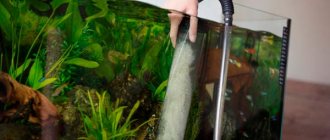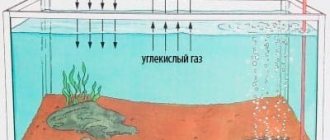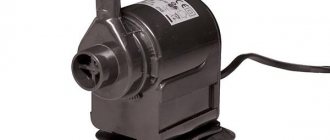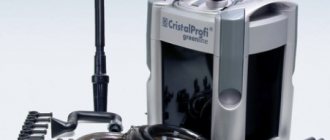Purpose
Uneaten food, silt and excrement pollute the soil and aquatic environment and cause poisoning in fish. As a result, their immunity sharply decreases, their color fades, they become lethargic and restless. There are some species of fish for which the accumulation of waste in the ground is deadly.
An aquarium cleaning siphon is a useful invention that helps you quickly and easily clean a water container from unnecessary dirt that accumulates at the bottom.
Varieties
Today, aquarists have many different types of soil cleaners at their disposal. The operating principle is identical for different models. They differ in the types of drive and power supply. May have additional functions.
All devices according to the type of drive are divided into two groups:
- Electric siphons consist of a cylinder and a tube equipped with a pump. The operation of such devices is carried out from the mains or on batteries. The garbage, along with the water flow, rushes into the pocket designated for this purpose. The clean water is then returned back to the reservoir. The aquarium cleaning pump does not harm plants; its power is low. However, the device is quite fragile and the cost is high. Batteries need to be changed frequently.
- The mechanical siphon operates by gravity. Includes beaker, funnel and flexible tube. The smaller the diameter of the hoses and the narrower the funnel, the greater the suction force of water. It is more convenient to start pumping out liquid if the siphon is with a bulb. It is not possible to regulate the power of water flow. An additional container will be required to collect the pumped out water.
Electric siphon.
Mechanical siphon.
Aquariums of any shape and size can be cleaned with such devices. If the pollution is very strong, there is a lot of algae, it is better to choose a device with a pump.
Types of siphons
Today there are many different types and models of siphons on the shelves of specialty stores. Their operating principle is identical, the difference is in the types of drive, power supply and the availability of additional options. Depending on the type of drive, the devices are:
- Electrical. In addition to the standard components in the form of a tube and a glass, this device has a pump that operates from the mains or using batteries. It is with the help of the pump that the waste is collected. All waste goes into a special pocket, and clean liquid is returned back to the aquarium. The device is convenient to use, does not harm plant roots, and has high power. However, there are a number of disadvantages: the device is fragile, requires frequent replacement of batteries, and is expensive.
The electric siphon has a pump for collecting debris from the ground
- The mechanical device operates by gravity. It contains a funnel, a hose and a glass. The pressure depends on the width of the hoses and funnel - the narrower they are, the greater the force with which the liquid is suctioned. Many models are equipped with bulbs, with the help of which pumping begins. This siphon is quite easy to use, does not require special skills, is suitable for processing any aquarium, and is accessible to everyone. The disadvantages include the impossibility of adjusting the power of liquid flow and the difficulty of working in places where algae accumulate. In addition, an auxiliary water collection tank is required for subsequent filtration.
In fact, the design is quite simple; if you wish, it is quite possible to make a homemade device at home.
Mechanical siphon suitable for all aquariums
How to use a siphon correctly
Cleaning the soil with a siphon should be done once a month. It is advisable to start any aquarium cleaning process with areas free of algae and decoration. Using a funnel you can slightly stir up the soil. The heavier one will settle to the bottom, and light debris will rush into the siphon tube.
Using a homemade or traditional mechanical siphon is not difficult. There are several ways:
- The end of the tube is lowered to the bottom of the reservoir. The second end is lowered below the ground line. They sharply draw in water with their mouth so that it flows by gravity up the hose.
- There is another way to force water and debris to pour out. Close the drain hole while simultaneously immersing the funnel into the aquarium. After this, lower the second end of the hose into the basin.
- Cleaning the soil with a mechanical aquarium soil cleaner equipped with a blower is even easier. The initial absorption of water occurs due to the vacuum created. No effort is required, just work a little with the pear.
As for electric models, everything is simple. Immerse the funnel in your home pond and turn on the device. Continue cleaning until the soil is clean. A 50 liter tank will take approximately 20 minutes.
Attention! After cleaning is completed, the water level is replenished to the original level. In one procedure, you can drain up to 30% of the water. A drastic change in the established ecosystem will negatively affect the well-being of fish.
We make it ourselves
To keep your aquarium clean, you don’t have to buy an expensive device. Now you will learn how to make a siphon for an aquarium, and what you will need for this. First, let's look at a few important points. First, it is better to use a transparent hose to visually monitor the suction of debris. Secondly, the diameter of the hose must be such that debris can be sucked in without problems and does not clog it. A very large diameter, on the contrary, will speed up suction, which is also not very good.
Materials and tools
- A piece of silicone tube;
- plastic bottle 0.5 l;
- silicone sealant.
Step-by-step instruction
- Cut off the top of the bottle, about 3 cm.
- We make a hole in the cork that matches the diameter of the silicone tube.
- We insert the tube and fix it with sealant. Let it dry.
- In this simple way you will get your own homemade cleaning device. Who knows, maybe the next one will be a siphon for carbonating water with your own hands, but for now, start cleaning the aquarium.
Popular manufacturers
There is now a large selection of aquarium soil cleaners on the market. The most popular manufacturers are:
- EHEIM. The company produces the best aquarium siphons, which not only drain liquid and debris into a separate container, but also filter it efficiently. Then the water returns to the reservoir. The nozzles have a special design that prevents injury to aquatic life. The devices operate on batteries or from the mains.
- Hagen. Engaged in the production of convenient and modern devices for maintaining an aquarium. Automated models are equipped with long hoses. Mechanical devices with a pump are also produced, which are much cheaper than electric ones.
- Tetra. The company produces siphons for every taste. Huge selection of budget models. The products are distinguished by high build quality and durable materials.
- Aquael. The Polish company provided serious competition to leading German manufacturers. The devices are of excellent quality and affordable. Provide user convenience and safety for aquatic life.
Siphon from EHEIM.
Siphon from Hagen.
Siphon from Tetra.
Siphon from Aquael.
The listed brands are among the leaders in product sales. Each manufacturer's line of siphons includes a huge variety of electrical or mechanical models.
Types of aquarium siphons
Aquarium siphons come in 2 types:
- electric, they run on batteries;
- mechanical.
Models may differ slightly from each other. The filter consists of a glass and a hose, so they are the same not only in composition, but also in the method of use. The filter must be lowered into the aquarium and installed vertically at the bottom. Silt, dirt, leftover food and excrement will eventually begin to flow by gravity into the glass, after which they flow down the hose and fall into the water container. When you see that the water flowing from the aquarium into the glass has become light and clean, move the siphon with your own hands to another contaminated area.
A standard mechanical siphon consists of a hose and a transparent plastic cylinder (glass) or funnel with a diameter of at least five centimeters. If the diameter of the glass is small and the aquarium is not high, then not only dirt will get into the siphon, but also stones that will fall into the hose. A prerequisite is that the siphon must be transparent so that you can move the device to another place in time when you notice that clean water is already entering the glass. You can purchase an industrial siphon at any store for aquarium lovers. There are many companies that produce high-quality filters.
Interesting: Bottom filter for an aquarium: what is it?
How to make a siphon for an aquarium with your own hands
A homemade siphon will cope with the task no worse than a store-bought siphon, if done correctly. The manufacturing process is simple, but requires care and skill in working with tools.
Tool and material
To make a mechanical siphon with your own hands, you need to prepare the following tools and materials:
- flexible transparent hose 2 m long, internal diameter 4 mm;
- a rigid tube 20 cm long, internal diameter 4 mm;
- two 20 cc syringes;
- a plastic cap that will tightly close the syringe;
- drill;
- two drills for 6 mm and 3 mm;
- heat gun;
- ruler;
- sharp knife;
- awl.
The home handyman needs to prepare a well-lit place for work with access to an electrical outlet.
Manufacturing stages
A properly assembled siphon for soil will last a long time, it will take a little time to manufacture it, and the price is disproportionately lower than that of a store-bought one.
Making a siphon in stages:
- First, the upper part of the siphon is made. All protruding parts are cut off from the first syringe with a knife. The resulting cylinder is plugged with a lid.
- Using an awl, mark holes in the center of the cap and the opposite side of the syringe. Use a drill with a 6 mm drill to drill the marked holes.
- A piece of rigid tube is cut along the length of the syringe, which should protrude 20-30 mm from the side of the cap, and 1-2 mm from the other side. Insert the tube into the syringe.
- After this, remove the plastic cover along with the tube. Mark a hole on the tube with a distance of 1-2 mm from the inner surface of the lid. Pull out the tube and drill a hole in it with a 3 mm drill. Air will be pushed out through it.
- The resulting burrs are cut off. Insert the tube back into the syringe and place the flexible hose on the protruding part. The top part is ready.
- Now we move on to making the lower part. Cut off all excess protruding parts and the bottom of the cylinder from the second syringe.
- Use a lighter to heat the end of the second syringe and place it on the first. To better fix the joints, use a heat gun. Another option is to tighten two syringes with heat shrink tubing.
The automatic siphon is ready. The principle of its use is simple. To clean the soil, a funnel glued together from two syringes is immersed in the aquarium. The end of the hose is lowered into a container located below the aquarium. The water pushes air into the hole of the tube and begins to suck up fish waste from the bottom. Working with this homemade device is a pleasure.
Video material
In the presented video you can see how to properly make a homemade siphon for an aquarium.
How to make an aqua vacuum cleaner, mechanical and biofilter from a Chinese pump.
Surely every aquarist has an old Chinese (but working) circulator pump gathering dust somewhere in a cabinet.
So that it does not gather dust, but continues to serve you faithfully for several more years, let’s make a biofilter and an aqua vacuum cleaner out of it.
What you will need: 1. An old circulator pump. 2. Two plastic bottles of 1.5 and 2.5 liters. 3. Silicone hose or siphon for soil. 4. Tool (awl, scissors, pliers) 5. PVC tube (for wires). 6. Rigid single-core wire in insulation. 7. A piece of food mesh (cell diameter from 0.2 mm to 0.5 mm) 8. Synthetic padding, bioceramic rings or bioballs. 9. Workplace. 10. Fishing line and needle. 11. Electrical tape or fumlenta.
Step 1 First, we assemble all the components of our aquavacuum cleaner-filter at the workplace.
step 2 Cut the 2.5 liter bottle into 3 parts as in the photo. You will get a neck, a ring and a bottom. Neck height 17cm, bottom 10cm, rings 4cm, cut off excess and throw away. Using a sharp knife, we cut out drain holes with a diameter of 1 cm (5 pieces) in the bottom, and in the upper part we make a vertical cut of 2.5 -3 cm (to make it easier to connect the bottle). Next, we take the ring and use pliers to make an S-shaped bend of 3 mm on it (which will make it narrower and it will fit into the bottle without squeaking). Take an awl, heat it on a candle or gas and make holes along the edge of the ring in 2mm increments around the entire circumference.
step 3 Next, take a ring with ready-made holes, put it on a new toilet roll (since it matches the diameter) so that the holes are 0.5 cm higher than the roll and secure it with tape. We take a piece of food mesh to size and sew it to the ring (using fishing line and a needle). It will look like a sieve.
step 4 Next, take the bottle cap and use an awl to make a hole in it with a diameter similar to your hose. We process the edges with a file or pliers.
Step 5 We make the actual aquavacuum cleaner itself. Take a piece of PVC pipe with a diameter of 15 mm. 15-17 cm long, punch a hole in the bottle cap (as in the previous step) slightly smaller than the diameter of the 14 mm tube, and insert (drive) it into the cap so that there is not a single crack and it fits very tightly. Then you can treat it with sealant (but I didn’t do this, since the connection turned out to be airtight). We take our old siphon, separate the cone (flask) from it and connect it (using a solid piece of hose suitable in diameter) to the other end of the tube. It should look like in the photo.
step 7 Remove the mesh cone from the pump (if this cone or tube is smaller in diameter than the bottle cap, then make a hole in the lid), wrap electrical tape or fumlent around the ring on the pump so that you can screw our siphon (stopper) very tightly like a bottle.
step 8 We put (tightly screw) a homemade siphon onto the pump (which we made in step 5).
step 9 If you don’t want to worry about the previous step, there is a simpler option. Just cut off the bottom of a 0.33-05 plastic bottle and put a mesh on the cone, as in the photo. Place a piece of large-pored dishwashing sponge (top part) inside the bottle (in the neck). True, with such a siphon you will have to stick your hand deeper into the aquarium...
step 10 We plug all unnecessary outlets from the pump with rubber plugs (for me this is an outlet for aeration), leaving the most important one. Cut a 4cm piece of silicone hose and put it on the outlet of the pump (discharge). This will be our adapter for our hose.
step 11 Assembling our structure. We insert the ring with the mesh into the upper part (neck), fill the rest tightly with synthetic padding and connect both parts into one.
step 12 We insert the hose into the cover with a hole and screw it onto an improvised dirt collector. We attach the second end of the hose using a piece of silicone hose to our electric siphon. We attach a piece of single-core wire to the dirt collector in order to hang it inside the aquarium (you don’t have to hang it).
step 13 We place this entire structure (siphon, pump, hose and dirt collector) into the aquarium and siphon.
step 14 Have you cleaned the soil? We disassemble our electric siphon and make a biofilter from the same pump, cut the 1.5 bottle in half, cut off the lower part so that 6-6.5 cm remains of it, make holes in the bottom with a diameter of 05-1 cm.
step 15 Fill with bioceramics and synthetic padding, connecting both parts. We insert a mesh into the cone (some bottles are not suitable, look for ones with thinner walls in the neck), a pump and immerse it in the aquarium (for aesthetes, you can wrap the bottle in Javanese), secure it wherever you want and launch.
step 16 After you have started the biofilter, you are left with a hose, a piece of PVC pipe (40 cm) and a cone (flask) from the siphon. We assemble a regular siphon for soil from this.
step 17 Insert the hose on one side of the tube, and on the other end through an adapter made from a piece of solid hose into a cone (flask). The siphon is ready.
step 18 This system or constructor can be used without a pump. We simply hang the dirt collector in a bucket and siphon it as usual (while inserting the end of the hose into the neck of the dirt collector). And then we pour the purified water back into the aquarium.
Tips and warnings:
1. You can use any bottles (color, size)
2. The sealing ring made of electrical tape is reusable (after use, pry it off with a screwdriver and remove it until next use)
3. The power of the pump must be at least 600 l/h (otherwise the flow will be small) The cost of a used pump is 200-400 rubles (650.1200 l/h) 4. After using the aqua vacuum cleaner, it is necessary to rinse and dry the padding polyester, the ring and the mesh ,
5. The dirt container must be removed from the bottom (otherwise it will open under its own weight and your work will be in vain) 6. The pump must be immersed in water below the impeller to avoid air suction.
How to care for the siphon
There is nothing complicated about servicing a siphon. At the end of work, it should be rinsed with clean running water. The funnel is washed especially thoroughly. Detergents can harm fish if their traces remain on structural parts. Therefore, it is better not to take risks. If necessary, you can use baking soda.
On a note! Even with proper care and storage, from time to time the hose of a homemade siphon must be replaced with a new one. To see how dirty the parts have become, the tubes and funnel should be made of transparent material.
A siphon for cleaning an aquarium is a mandatory attribute, without which it is impossible to maintain ecological balance in the aquatic environment. It allows you to clean the bottom of the aquarium without frequent water changes. A siphon made by yourself will also successfully cope with the task. If you liked the article, leave comments and share a link to it on social networks.
Cleaning and storing the device
A DIY siphon is very easy to maintain and clean. Upon completion of cleaning the aquarium, you need to disassemble all parts and rinse thoroughly under running water. If desired, you can use a soapy solution to wipe down the funnel. After this, you need to rinse it well and dry it thoroughly with a cloth. It should be noted that all detergents can harm fish, so you need to thoroughly rinse all parts of the structure.
As needed, for example, when dirty stains are no longer washed off or deposits clog the hose, you can replace it or make a new design. Cleaning the soil in an aquarium using a siphon is a very important procedure that does not take much time and effort. To clean a structure with a capacity of 50 liters, 10-15 minutes are enough. The benefits of such a homemade device are invaluable.











